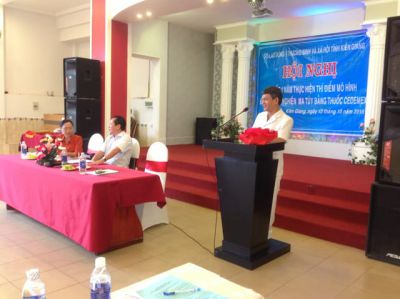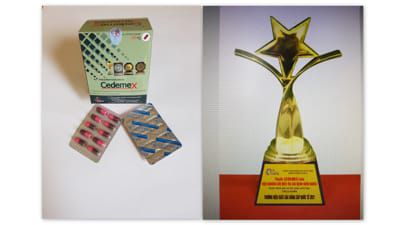Lai Thuat*, Ta Hai Nguyen*, Nguyen Phu Kieu**, Hoang Nhan Ban*
*Institute for Pharmacology, Guangxi Medical University, China.
**Vietnam Institute for Research and Treatment of Critical Diseases
ABSTRACT
Purpose: To observe if Cedemex has the ability to prevent drug relapse (the psychological dependence on morphine) or not.
Method: Carry out the experiment "Conditioned Place Preference" (CPP) to establish a model of house-mouse of psychological dependence on morphine, evaluating the effect of Cedemex against psychological dependence on morphine.
Results: The groups using high-dose Cedemex, medium dose Cedemex and low dose Cedemex are treated with the medicine for 5 consecutive days, continue to be treated with Hydrocortisone. The time that house-mice like the white boxes does not last long, the white-box-preference behavior does not repeat, which has become an unconditioned position preference. For the house mice group using morphine and the group using saline solution, the time spent in the white boxes is significantly increased, the white-box-preference behavior repeats.
Conclusion: Cedemex has a relatively strong effect in preventing relapse (psychological dependence on morphine).
Keywords: Cedemex, morphine, CPP experiment, psychological dependence.
Drug addiction is a chronic disease easily repeated in the brain, in which the structure and function of the nervous system have changes, many experimental studies have proved this conclusion [1,2,3]. Opiate dependence is a thorny problem of society and medicine. Opiate addiction is mainly indicated in the form of physical addiction (physical dependence) and psychological addiction (psychological dependence). Physiological addiction indicates the development of the symptoms of withdrawal syndrome, for example in terms of clinical treatment, the alternative medication method is usually applied to temporarily overcome physical addiction. Psychological addiction, after stopping the attack for a time, can't still inhibit intense drug cravings, so most addicts can't resist the drug cravings. For psychological addiction, the traditional treatment methods have little effect. Therefore, among drug patients to detoxify, the relapse rate was higher than 90%.
Craving and relapse behaviors are closely related to Glucocorticoides level under the conditions of drug missing irritation and activation [4,5]. After forming psychological dependence on morphine, house mice will happen to like just boxes containing morphine of CPP cage, over a certain period of time (about 9 days), their preference for boxes containing morphine will be lost. However, when using Hydrocortisone (5mg/kg, injected subcutaneously) their preference for boxes containing morphine may reoccur. It can be said that those mice "relapsed". The experimental results demonstrate that Cedemex has effects to stop the re-occurrence of the preference for boxes containing morphine under the stimulation of exogenous Glucocorticoides.
1. Materials and machinery
1.1 Medicines
- Cedemex, in the form of capsule, 500mg/capsule, provided by Vietnam Institute for Research and Treatment of Serious Diseases.
- Naloxone clohydrat injection solution, produced by Ich Kieu Pharmaceutical Limited Company (Hunan), batch number:: 20030706.
- Morphine hydrochloride injection solution, produced by Shenyang Pharmaceutical Enterprise No.1 , batch number: 20040402.
1.2 Animals: Kunming house mice, male and female of equal numbers (male and female mice are raised in separate cages, avoiding female mice to be pregnant because pregnancy increases their body weight ... affecting experimental results), 20 ~ 24g, provided by the laboratory animal center at Guangxi Medical University.
1.3 Equipment and machinery: The cage, which is used to carry out the experiment on conditioned place preference, has two rectangular boxes. The color of the two boxes is different, black and white, four glossy walls, distinctive floors with rough surface and smooth surface, there is a passage-way through the two boxes. Equipment, cameras, and behavioral analysis system are provided by Shanghai Zhuge Liang Software Co., Ltd.
2. Methodology
2.1 The model of spiritual morphine dependence [4,5]
Use the experimental cage for conditioned place preference (CPP) to conduct the experiment under quiet conditions. Firstly, select house mice for the experiment, place mice on the passageway of the 2-box cage, allow them to explore the 2 black and white boxes for 5 minutes, then record their time staying in the black box for 15 minutes. Continuously conduct the experiments in 3 consecutive days. Select those mice that only prefer the black box to conduct experiments. Random divide them into groups. In the morning (at 9 am), dose them morphine with creasing doses, respectively 20mg/kg, 40mg/kg, 60mg/kg, 80mg/kg, 100mg/kg, 100mg/kg, 100mg/kg, injected subcutaneously, then immediately drop in the white box, keep them there for 60 minutes. In the afternoon (at 15 pm), subcutaneously inject them with NaCl 0.9% and then drop into the black box. Each time, keep them for 60 minutes, in 7 consecutive days. The mice, after being training to use morphine, shifting their preference from the black box to the white box, forming the dependence on morphine. On days 8, 9, 10 (after stopping using morphine on days 1, 2, 3), drop each of the mice into the cage, do not record for the first 5 minutes, then record their time in the black box for 15 minutes. Later, after one observed day, only record once, until observe the mice recovering their previous preference for the black box as before dosing.
2.2 Animal group distribution and dosing
For mice addicted to morphine stopping using it for 9 days, their preference for the white box disappears. Randomly divide them into 5 groups, including: The control group, the morphine group (positive control group), the low dose Cedemex group, the medium-dose Cedemex group and the high dose Cedemex group, each group has 10 mice.
- The control group is dosed with NaCl injection solution.
- The morphine group (positive control group): continue using morphine.
- Three remaining groups are dosed Cedemex continuously for 5 days, twice a day.
On day 6, subcutaneously inject the relapse medicine Hydrocortisone, after 15 minutes, drop the mice into the cage, allow then to explore the two black and white boxes for 5 minutes, then observer and note the their time in the black box.
2.3 Processing statistical data
Use the statistical software SPSS for data processing, the data uses (![]() ± s) to denote, compare between Test t-groups.
± s) to denote, compare between Test t-groups.
3. Experimental results
After using morphine, the mice groups' staying the black box significantly reduced, proving that mice generated the preference for the black box. It means that the mice formed a morphine dependence, see Table 1.
Comparing the average time in the black box between the mice group using high dose Cedemex, on average, for the mice group before using morphine and Cedemex, after using Hydrocortisone, the difference was not statistically significant. Comparing with the group after using morphine, the difference is statistically significant, proving that 2 medium and high Cedemex doses have effects to remove their preference for the white box. It means that Cedemex has a relatively strong effect on controlling their psychological dependence on morphine (anti-relapse effect), see Table 1.
Comparing the average time in the black box between the mice group using low-dose Cedemex after using Hydrocortisone with the mice group before using Cedemex, the difference is not clear. However, compared to the mice group before using morphine, the difference is statistically significant, compared with the group after using morphine, the difference is very clear, proving that low dose Cedemex eliminated their preference for the white box. It means that low dose Cedemex also has effect fighting against the psychological dependence on morphine, see Table 1.
Comparing the average time in the black box between the mice group using morphine after using Hydrocortisone with the group before using morphine and the group before continuing to use morphine, the difference is very clear, but compared with the group after using morphine, the difference is not clear, proving that Hydrocortisone has no ability to eliminate their preference for the white box, see Table 1.
Comparing the average time in the black box between the mice group using the NaCl 0.9% solution after being stimulated with Hydrocortisone with the mice group before using morphine and before using drug detoxification medicine, the difference was statistically significant, but compared to the mice group after using morphine, the differences is not clear, proving that the NaCl 0.9% solution is not capable of eliminating their preference for the white box, and Hydrocortisone is capable of stimulating their preference for the white box. It means that it is likely stimulate mice to produce morphine relapse behavior, see Table 1.
Table 1 Average time in the black box of the mice
(unit: second), (X±s, n=10)

Compared with the group after using morphine: ***P<0.001;
Compared with the group after being stimulated with Hydrocortisone #P <0.05;
Compared with the group before using morphine and the group before continuing using morphine: ∆∆∆P<0.001;
Compared with the group before using morphine and before using NaCl 0.9% solution ▼▼▼P< 0.001.
Note: Note: 3 mice groups using high dose Cedemex, medium dose Cedemex, low dose Cedemex, the mice group using morphine, the mice group using NaCl 0.9% solution before using Hydrocortisone are respectively dosed Cedemex, morphine and NaCl 0 , 9% solution.
4. Discussion
In recent years, the CPP experiment has become an effective experiment widely used to evaluate the potential of the psychological dependence on drugs, after morphine created a conditioned place preference, maintaining for about 30 days [7]. There are many kinds of stimulants for irritation, in animal experiments, commonly used methods are required swimming, electric shock, isolation, limited feeding... General characteristics of irritation are the activation of Hypothalamic-Pituitary-Adrenal (HPA) Axis, making the adrenal release Glucocorticoides. Exogenous Glucocorticoides can increase the dopamine release in the NAcc and VTA, making the body producing psychological response and opiate or mental stimulant dependence behavior, which increases the conditioned place preference for morphine of mice, achieving the same irritation results [5].
The experimental study results also prove that Hydrocortisone has the ability to stimulate mice to produce morphine relapse behavior, while Cedemex strongly fights against morphine relapse behavior.
In summary, using CPP experiment, morphine and Hydrocortisone are capable of establishing the model of psychological dependence on morphine, while Cedemex is strongly able to resist the psychological dependence on morphine.
REFERENCES
1) Diep Quan, Mong Vi Khanh, Vi The Tu...
Developing the heroin relapse model
Studies report of Guangxi Medical University 2003, 20(6), 832-835
2) Vi Tien Luong, Chu Yen
Research on the structural changes of brain micro tissues of sewer-rats addicted to heroin
Study report of Guangxi Medical University, 2003, 20 (6) 835-837
3) Ly Loi Hoa
Research on pathological changes of the microstructure of the immune system and the nervous secretion of heroin addicts
Chinese Journal of Forensic Medicine, 2001, 17 (3), 145-147
4) Bac Thu Sinh, Bao Yen Yen, Y Thuc Chan...
Studies of the effects of the complete Alcaloide of Yunnan dog's-tooth violet in preventing the relapse place preference in mice addicted to morphine
Medical Journal of Chinese People's Liberation Army, 2004, 20 (5), 352-355
5) Luc Lan, Hoang Minh Sinh, Ly Tinh...
Research on the boosting effect of Glucocorticoide and forced swimming promoting the conditioned place preference of house mice to morphine
Chinese Journal of Psychiatry 2000, 33 (1). 35-37
6) Van Hung Vuong, Hoang Mau, Ly Van Hoi
Study of the experimental model used to assess the psychological dependence of drug
Study report of Army Medical University, 1998, 19 (4), 383-384
7) Dao Thanh, Trinh Tiep Vuong
Experiment on conditioned place preference
Notice of Chinese drug dependence, 1996, 5 (2), 68-73.











